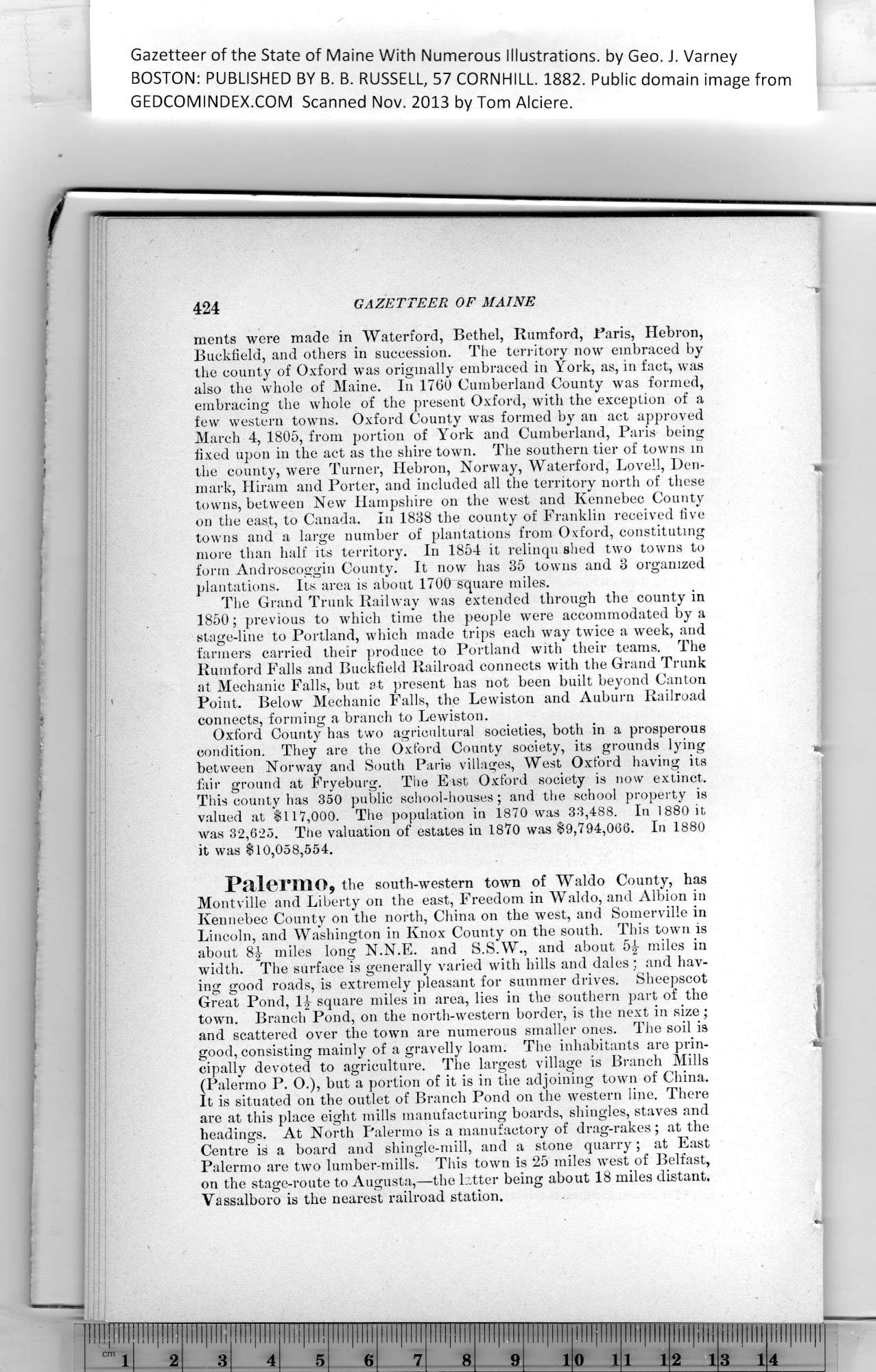|
Gazetteer of the State of Maine With Numerous Illustrations, by Geo. J. Varney
BOSTON: PUBLISHED BY B. B. RUSSELL, 57 CORNHILL. 1882. Public domain image from
424 GAZETTEER OF MAINE
ments were made in Waterford, Bethel, Rumford, Paris, Hebron,
Buckfield, and others in succession. The territory now embraced by
the county of Oxford was originally embraced in York, as, in fact, was
also the whole of Maine. In 1760 Cumberland County was formed,
embracing the whole of the present Oxford, with the exception of a
few western towns. Oxford County was formed by an act approved
March 4, 1805, from portion of York and Cumberland, Paris being
fixed upon in the act as the shire town. The southern tier of towns in
the county, were Turner, Hebron, Norway, Waterford, Lovell, Den-
mark, Hiram and Porter, and included all the territory north of these
towns, between New Hampshire on the west and Kennebec County
on the east, to Canada. In 1888 the county of Franklin received five
towns and a large number of plantations from Oxford, constituting
more than half its territory. In 1854 it relinquished two towns to
form Androscoggin County. It now has 35 towns and 3 organized
plantations. Its area is about 1700 square miles.
The Grand Trunk Railway was extended through the county in
1850; previous to which time the people were accommodated by a
stage-line to Portland, which made trips each way twice a week, and
farmers carried their produce to Portland with their teams. The
Rumford Falls and Buckfield Railroad connects with the Grand Trunk
at Mechanic Falls, but at present has not been built beyond Canton
Point. Below Mechanic Falls, the Lewiston and Auburn Railroad
connects, forming a branch to Lewiston.
Oxford County has two agricultural societies, both in a prosperous
condition. They are the Oxford County society, its grounds lying
between Norway and South Paris villages, West Oxford having its
fair ground at Fryeburg. The East Oxford society is now extinct.
This county has 350 public school-houses; and the school property is
valued at $117,000. The population in 1870 was 33,488. In 1880 it
was 32,625. The valuation of estates in 1870 was $9,794,066. In 1880
it was $10,058,554.
Palermo, the south-western town of Waldo County, has
Montville and Liberty on the east, Freedom in Waldo, and Albion in
Kennebec County on the north, China on the west, and Somerville in
Lincoln, and Washington in Knox County on the south. This town is
about 8|- miles long N.N.E. and S.S.W., and about 5^- miles in
width. The surface is generally varied with hills and dales ; and hav-
ing good roads, is extremely pleasant for summer drives. Sheepscot
Great Pond, 1\ square miles in area, lies in the southern part of the
town. Branch Pond, on the north-western border, is the next in size;
and scattered over the town are numerous smaller ones. The soil is
good, consisting mainly of a gravelly loam. The inhabitants are prin-
cipally devoted to agriculture. The largest village is Branch Mills
(Palermo P. O.), but a portion of it is in the adjoining town of China.
It is situated on the outlet of Branch Pond on the western line. There
are at this place eight mills manufacturing boards, shingles, staves and
headings. At North Palermo is a manufactory of drag-rakes; at the
Centre is a board and shingle-mill, and a stone quarry; at East
Palermo are two lumber-mills. This town is 25 miles west of Belfast,
on the stage-route to Augusta,—the Utter being about 18 miles distant.
Vassalboro is the nearest railroad station.
PREVIOUS PAGE ... NEXT PAGE
This page was written in HTML using a program written in Python 3.2
|
